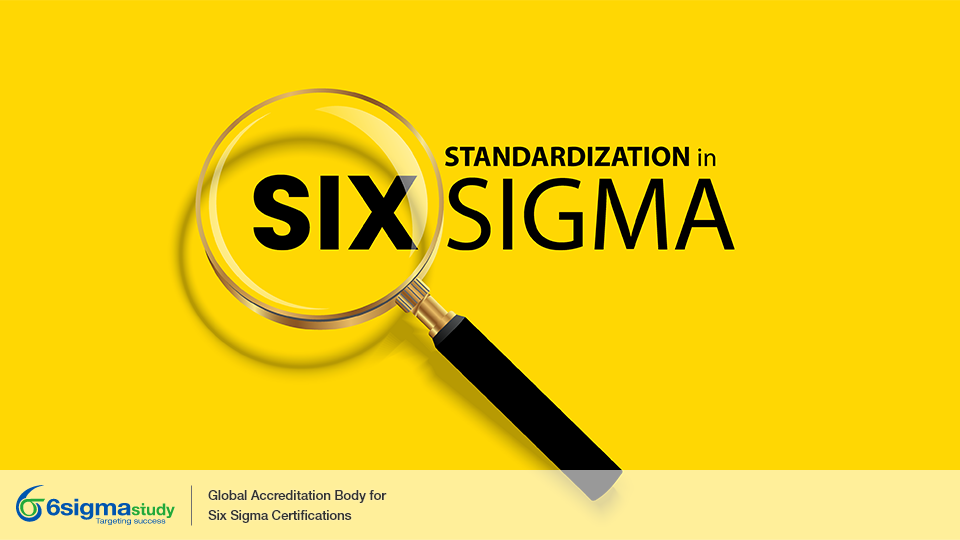Standardization in Six Sigma
Posted by 6sigmastudy® on November 21, 2023 | Six Sigma Methodology
Keywords: Six Sigma 6sigmastudy Standardization in Six Sigma Six Sigma Yellow Belt (SSYB™) Six Sigma Green Belt (SSGB™) Six Sigma Black Belt (SSBB™) Lean Six Sigma Green Belt (LSSGB™) Lean Six Sigma Black Belt (LSSBB™) Free Articles Free Six Sigma Articles TQM Six sigma define dmaic dmadv
In the domain of quality improvement methodologies, Six Sigma is considered to be the most successful framework designed to increase efficiency and reduce defects. Six Sigma is recognized as an essential component of standardized work. It concentrates on pinpointing and recording the most optimal and efficient method for executing a process. This article focuses on standardization of work using Six Sigma.
In Six Sigma, standardized work is a systematic approach aimed at identifying and documenting the most successful and effective method for executing a particular process. This provides a calculated analysis of each step, considering requirements such as materials, tools, and equipment. The primary goal is to find a standardized template that guarantees consistency, repeatability, and better outcomes.
The central objectives of Six Sigma integrates seamlessly with the principles of standardized work. Although Lean and Six Sigma are two different methodologies, they are often integrated as Lean Six Sigma for process optimization and quality improvement. The collaborative effectiveness of these methodologies are sufficed in DMAIC (Define, Measure, Analyse, Improve, Control), highlighting the data-driven approach to continuous improvement.
The implementation of ‘standardized work’ is focussed on achieving various goals such as
- Aligning output with customer demand,
- Formally capturing and documenting processes,
- Minimizing waste,
- Enhancing product quality,
- Boosting job satisfaction,
- Facilitating effective staff training, and
- Establishing a stable foundation for continuous improvement.
While achieving these goals may take time, continuous efforts ensure that staff consistently operates processes in accordance with the documented standards.
The application of standardized work has a lot of benefits such as:
- Continuity of the process: Standardized work ensures that processes, when executed as documented, are reliable and reusable, resulting in regular, high-quality outputs.
- Correct utilization of resources: By minimizing waste and optimizing processes, standardized work enables more efficient use of resources, including reduced scrap and increased value.
- Enhanced Efficiencies: The methodology provides proper training and onboarding, generates better outputs, and more trustworthy prediction of resources and materials.
- Base for Improvement: Standardized work provides a stable baseline from which organizations can initiate and sustain improvement efforts, fostering a culture of continuous improvement.
Despite having numerous advantages, standardized work is filled with challenges:
- Poor Process Design Decisions: The impact of standardized projects depends on well-designed processes, and poor decisions during the designing phase can hinder success.
- Lack of Training: Adequate training is important, as operators may deviate from standardized processes if they don’t have proper knowledge about it.
- Non-compliance with Documented Processes: Organizations frequently encounter the challenge of operators not clinging to documented processes, highlighting the need for a comprehensive understanding of the underlying reasons for this deviation.
In conclusion, standardized work in Six Sigma emerges as a potential tool for organizations aiming to optimize processes, eliminate waste, and maximize overall quality. Through a systematic approach, standardized work creates a strong base for achieving the goals of Six Sigma. Embracing this methodology ensures high speed and quality, setting the space for sustained success and adaptability in the changing business environment. Standardization is an important aspect of Six Sigma which is presented as a blueprint for the never-ending success stories.
For more such interesting articles on Six Sigma and its concepts, please click here

